Abstract
Uniparental disomy (UPD)-the inheritance of two homologous chromosomes from a single parent-may be unmasked in humans by the unexpected appearance of developmental abnormalities, genetic disorders resulting from genomic imprinting, or recessive traits. Here we report a female patient with familial chylomicronemia resulting from complete lipoprotein-lipase (LPL) deficiency due to homozygosity for a frameshift mutation in exon 2 of the LPL gene. She was the normal term product of an unremarkable pregnancy and had shown normal development until her current age of 5.5 years. The father (age 33 years) and the mother (age 24 years) were unrelated and healthy, with no family history of stillbirths or malformations. The father was a heterozygous carrier of the mutation, whereas no mutation in the LPL gene was detected in the mother. Southern blotting did not reveal any LPL gene rearrangement in the proband or her parents. The proband was homozygous for 17 informative markers spanning both arms of chromosome 8 and specifically for the haplotype containing the paternally derived LPL gene. This shows that homozygosity for the defective mutation in the LPL gene resulted from a complete paternal isodisomy for chromosome 8. This is the first report of UPD for chromosome 8 unmasked by LPL deficiency and suggests that normal development can occur with two paternally derived copies of human chromosome 8.
Full text
PDF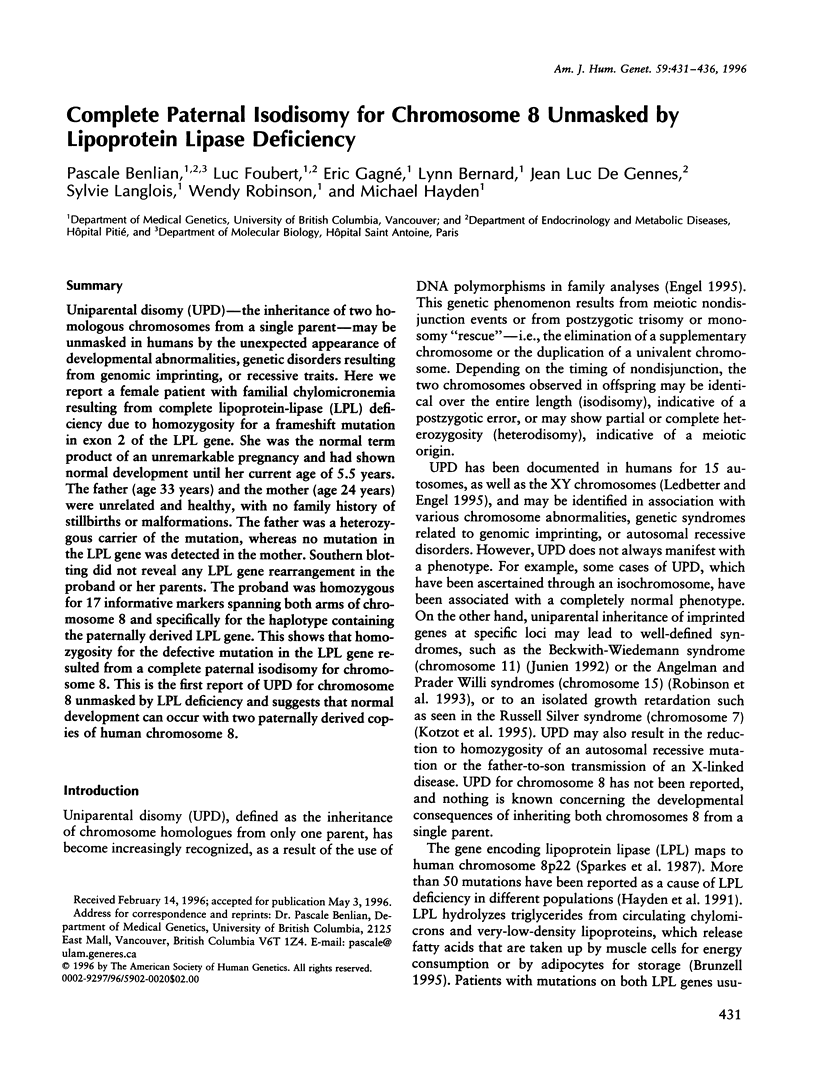
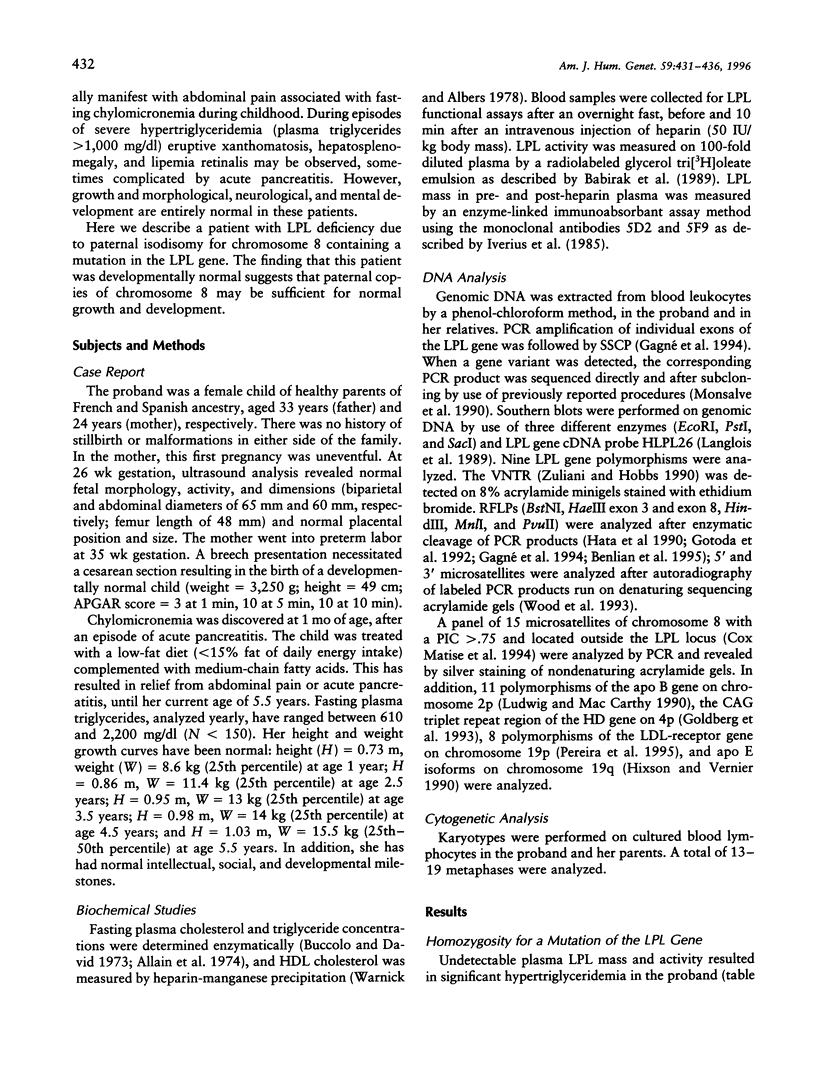
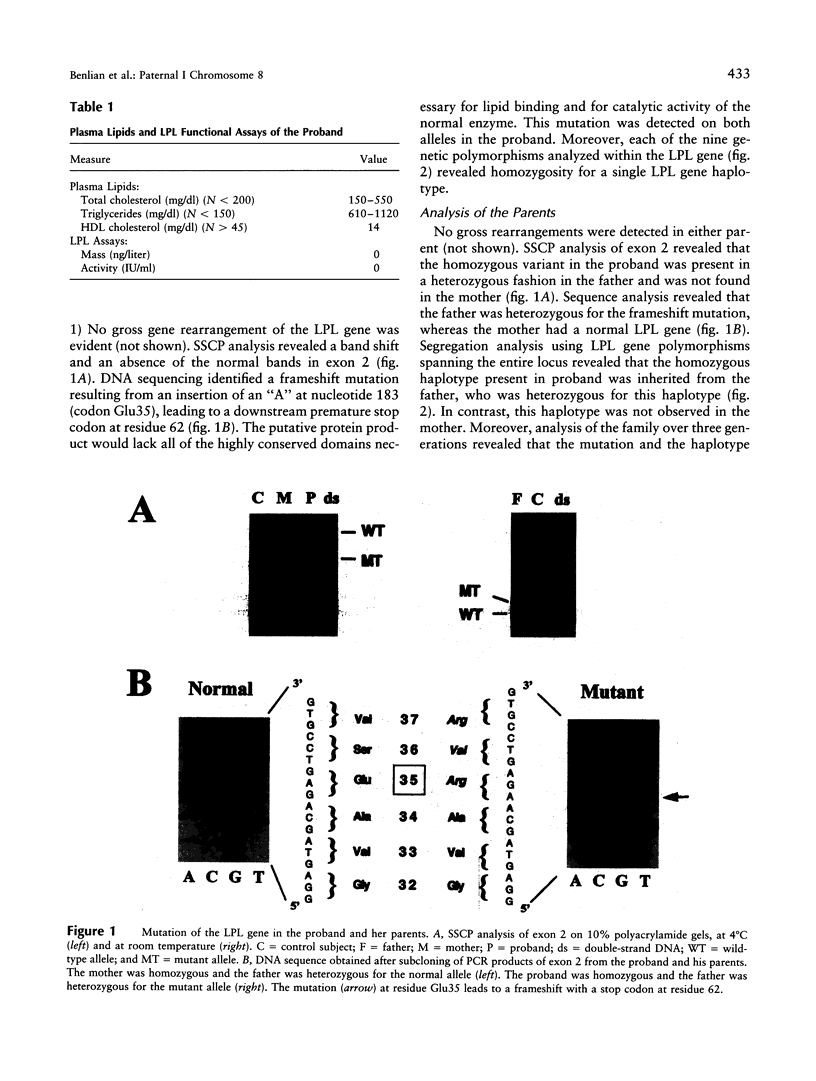
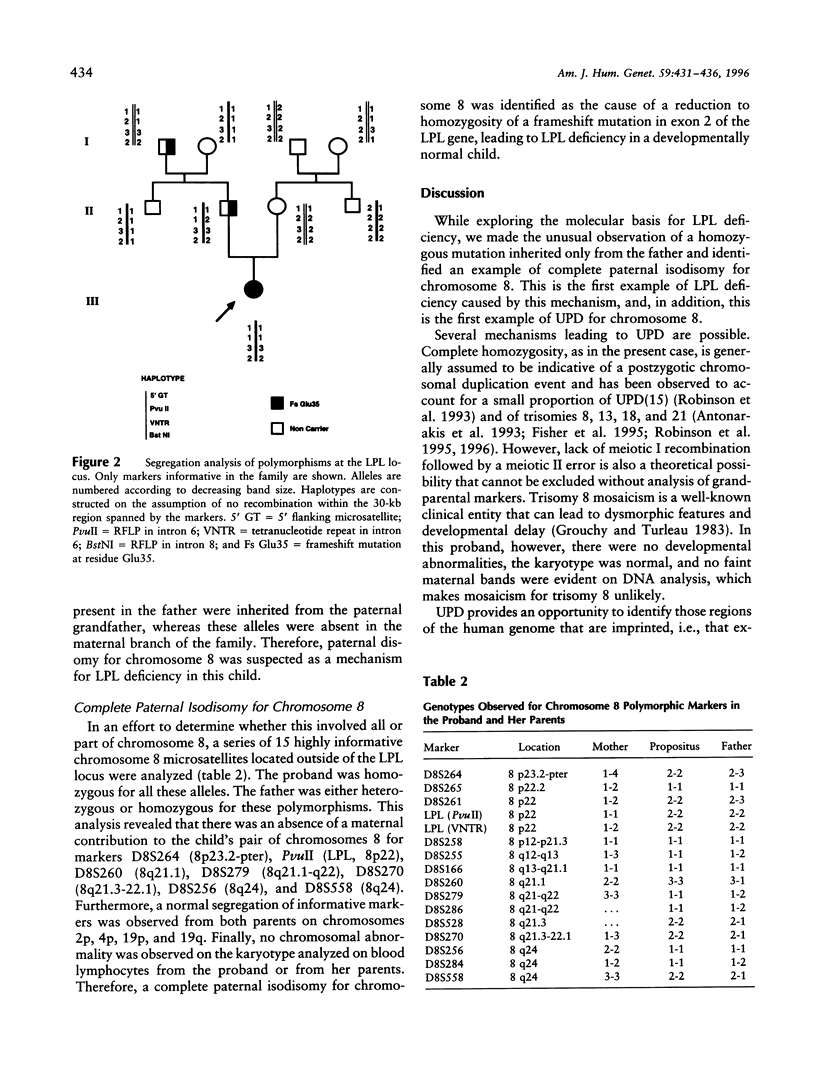
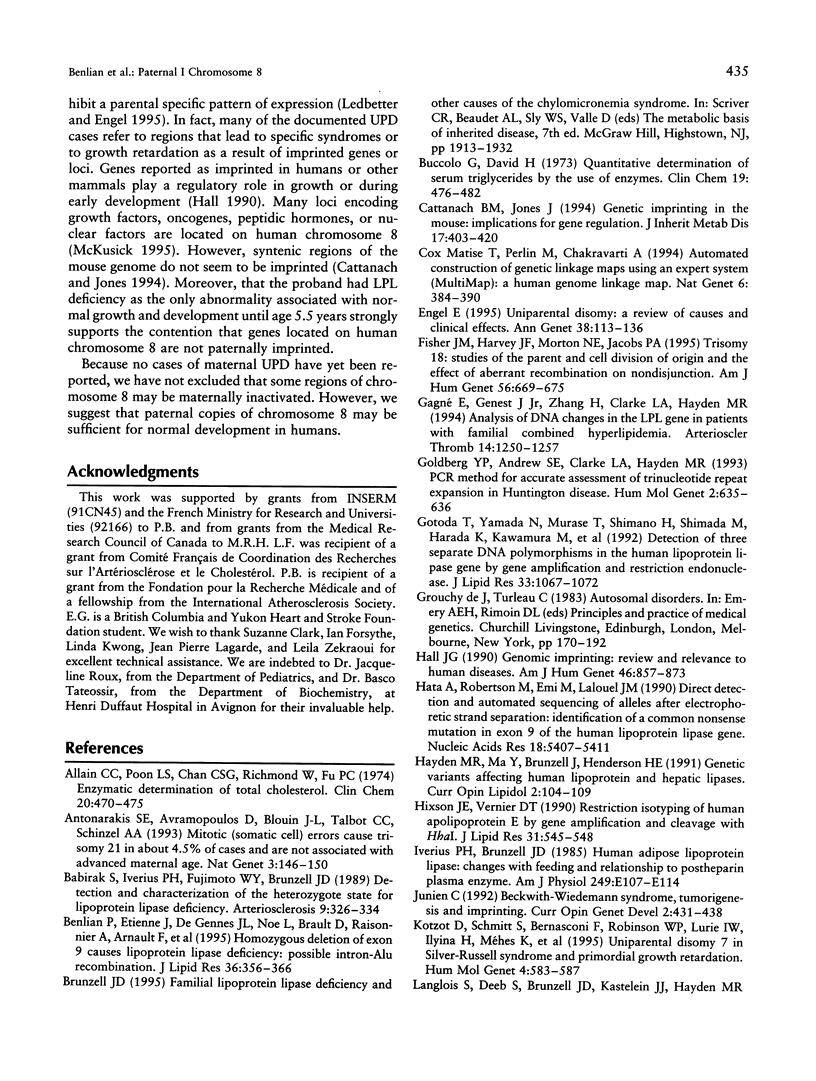
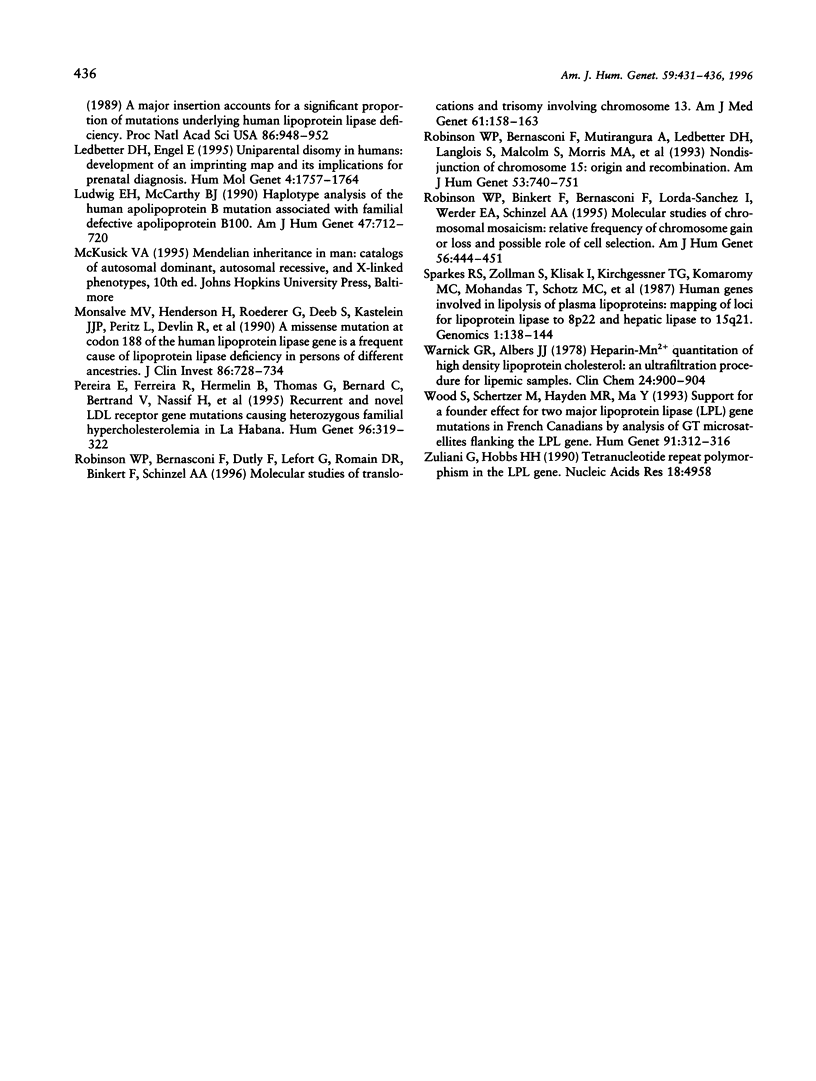
Images in this article
Selected References
These references are in PubMed. This may not be the complete list of references from this article.
- Allain C. C., Poon L. S., Chan C. S., Richmond W., Fu P. C. Enzymatic determination of total serum cholesterol. Clin Chem. 1974 Apr;20(4):470–475. [PubMed] [Google Scholar]
- Antonarakis S. E., Avramopoulos D., Blouin J. L., Talbot C. C., Jr, Schinzel A. A. Mitotic errors in somatic cells cause trisomy 21 in about 4.5% of cases and are not associated with advanced maternal age. Nat Genet. 1993 Feb;3(2):146–150. doi: 10.1038/ng0293-146. [DOI] [PubMed] [Google Scholar]
- Babirak S. P., Iverius P. H., Fujimoto W. Y., Brunzell J. D. Detection and characterization of the heterozygote state for lipoprotein lipase deficiency. Arteriosclerosis. 1989 May-Jun;9(3):326–334. doi: 10.1161/01.atv.9.3.326. [DOI] [PubMed] [Google Scholar]
- Benlian P., Etienne J., de Gennes J. L., Noé L., Brault D., Raisonnier A., Arnault F., Hamelin J., Foubert L., Chuat J. C. Homozygous deletion of exon 9 causes lipoprotein lipase deficiency: possible intron-Alu recombination. J Lipid Res. 1995 Feb;36(2):356–366. [PubMed] [Google Scholar]
- Bucolo G., David H. Quantitative determination of serum triglycerides by the use of enzymes. Clin Chem. 1973 May;19(5):476–482. [PubMed] [Google Scholar]
- Cattanach B. M., Jones J. Genetic imprinting in the mouse: implications for gene regulation. J Inherit Metab Dis. 1994;17(4):403–420. doi: 10.1007/BF00711356. [DOI] [PubMed] [Google Scholar]
- Engel E. La disomie uniparentale: revue des causes et conséquences en clinique humaine. Ann Genet. 1995;38(3):113–136. [PubMed] [Google Scholar]
- Fisher J. M., Harvey J. F., Morton N. E., Jacobs P. A. Trisomy 18: studies of the parent and cell division of origin and the effect of aberrant recombination on nondisjunction. Am J Hum Genet. 1995 Mar;56(3):669–675. [PMC free article] [PubMed] [Google Scholar]
- Gagné E., Genest J., Jr, Zhang H., Clarke L. A., Hayden M. R. Analysis of DNA changes in the LPL gene in patients with familial combined hyperlipidemia. Arterioscler Thromb. 1994 Aug;14(8):1250–1257. doi: 10.1161/01.atv.14.8.1250. [DOI] [PubMed] [Google Scholar]
- Goldberg Y. P., Andrew S. E., Clarke L. A., Hayden M. R. A PCR method for accurate assessment of trinucleotide repeat expansion in Huntington disease. Hum Mol Genet. 1993 Jun;2(6):635–636. doi: 10.1093/hmg/2.6.635. [DOI] [PubMed] [Google Scholar]
- Gotoda T., Yamada N., Murase T., Shimano H., Shimada M., Harada K., Kawamura M., Kozaki K., Yazaki Y. Detection of three separate DNA polymorphisms in the human lipoprotein lipase gene by gene amplification and restriction endonuclease digestion. J Lipid Res. 1992 Jul;33(7):1067–1072. [PubMed] [Google Scholar]
- Hall J. G. Genomic imprinting: review and relevance to human diseases. Am J Hum Genet. 1990 May;46(5):857–873. [PMC free article] [PubMed] [Google Scholar]
- Hata A., Robertson M., Emi M., Lalouel J. M. Direct detection and automated sequencing of individual alleles after electrophoretic strand separation: identification of a common nonsense mutation in exon 9 of the human lipoprotein lipase gene. Nucleic Acids Res. 1990 Sep 25;18(18):5407–5411. doi: 10.1093/nar/18.18.5407. [DOI] [PMC free article] [PubMed] [Google Scholar]
- Hixson J. E., Vernier D. T. Restriction isotyping of human apolipoprotein E by gene amplification and cleavage with HhaI. J Lipid Res. 1990 Mar;31(3):545–548. [PubMed] [Google Scholar]
- Iverius P. H., Brunzell J. D. Human adipose tissue lipoprotein lipase: changes with feeding and relation to postheparin plasma enzyme. Am J Physiol. 1985 Jul;249(1 Pt 1):E107–E114. doi: 10.1152/ajpendo.1985.249.1.E107. [DOI] [PubMed] [Google Scholar]
- Junien C. Beckwith-Wiedemann syndrome, tumourigenesis and imprinting. Curr Opin Genet Dev. 1992 Jun;2(3):431–438. doi: 10.1016/s0959-437x(05)80154-6. [DOI] [PubMed] [Google Scholar]
- Kotzot D., Schmitt S., Bernasconi F., Robinson W. P., Lurie I. W., Ilyina H., Méhes K., Hamel B. C., Otten B. J., Hergersberg M. Uniparental disomy 7 in Silver-Russell syndrome and primordial growth retardation. Hum Mol Genet. 1995 Apr;4(4):583–587. doi: 10.1093/hmg/4.4.583. [DOI] [PubMed] [Google Scholar]
- Ledbetter D. H., Engel E. Uniparental disomy in humans: development of an imprinting map and its implications for prenatal diagnosis. Hum Mol Genet. 1995;4(Spec No):1757–1764. doi: 10.1093/hmg/4.suppl_1.1757. [DOI] [PubMed] [Google Scholar]
- Ludwig E. H., McCarthy B. J. Haplotype analysis of the human apolipoprotein B mutation associated with familial defective apolipoprotein B100. Am J Hum Genet. 1990 Oct;47(4):712–720. [PMC free article] [PubMed] [Google Scholar]
- Matise T. C., Perlin M., Chakravarti A. Automated construction of genetic linkage maps using an expert system (MultiMap): a human genome linkage map. Nat Genet. 1994 Apr;6(4):384–390. doi: 10.1038/ng0494-384. [DOI] [PubMed] [Google Scholar]
- Monsalve M. V., Henderson H., Roederer G., Julien P., Deeb S., Kastelein J. J., Peritz L., Devlin R., Bruin T., Murthy M. R. A missense mutation at codon 188 of the human lipoprotein lipase gene is a frequent cause of lipoprotein lipase deficiency in persons of different ancestries. J Clin Invest. 1990 Sep;86(3):728–734. doi: 10.1172/JCI114769. [DOI] [PMC free article] [PubMed] [Google Scholar]
- Pereira E., Ferreira R., Hermelin B., Thomas G., Bernard C., Bertrand V., Nassiff H., Mendez del Castillo D., Bereziat G., Benlian P. Recurrent and novel LDL receptor gene mutations causing heterozygous familial hypercholesterolemia in La Habana. Hum Genet. 1995 Sep;96(3):319–322. doi: 10.1007/BF00210415. [DOI] [PubMed] [Google Scholar]
- Robinson W. P., Bernasconi F., Dutly F., Lefort G., Romain D. R., Binkert F., Schinzel A. A. Molecular studies of translocations and trisomy involving chromosome 13. Am J Med Genet. 1996 Jan 11;61(2):158–163. doi: 10.1002/(SICI)1096-8628(19960111)61:2<158::AID-AJMG11>3.0.CO;2-T. [DOI] [PubMed] [Google Scholar]
- Robinson W. P., Bernasconi F., Mutirangura A., Ledbetter D. H., Langlois S., Malcolm S., Morris M. A., Schinzel A. A. Nondisjunction of chromosome 15: origin and recombination. Am J Hum Genet. 1993 Sep;53(3):740–751. [PMC free article] [PubMed] [Google Scholar]
- Robinson W. P., Binkert F., Bernasconi F., Lorda-Sanchez I., Werder E. A., Schinzel A. A. Molecular studies of chromosomal mosaicism: relative frequency of chromosome gain or loss and possible role of cell selection. Am J Hum Genet. 1995 Feb;56(2):444–451. [PMC free article] [PubMed] [Google Scholar]
- Sparkes R. S., Zollman S., Klisak I., Kirchgessner T. G., Komaromy M. C., Mohandas T., Schotz M. C., Lusis A. J. Human genes involved in lipolysis of plasma lipoproteins: mapping of loci for lipoprotein lipase to 8p22 and hepatic lipase to 15q21. Genomics. 1987 Oct;1(2):138–144. doi: 10.1016/0888-7543(87)90005-x. [DOI] [PubMed] [Google Scholar]
- Warnick G. R., Albers J. J. Heparin--Mn2+ quantitation of high-density-lipoprotein cholesterol: an ultrafiltration procedure for lipemic samples. Clin Chem. 1978 Jun;24(6):900–904. [PubMed] [Google Scholar]
- Wood S., Schertzer M., Hayden M., Ma Y. Support for founder effect for two lipoprotein lipase (LPL) gene mutations in French Canadians by analysis of GT microsatellites flanking the LPL gene. Hum Genet. 1993 May;91(4):312–316. doi: 10.1007/BF00217348. [DOI] [PubMed] [Google Scholar]
- Zuliani G., Hobbs H. H. Tetranucleotide repeat polymorphism in the LPL gene. Nucleic Acids Res. 1990 Aug 25;18(16):4958–4958. doi: 10.1093/nar/18.16.4958-a. [DOI] [PMC free article] [PubMed] [Google Scholar]



